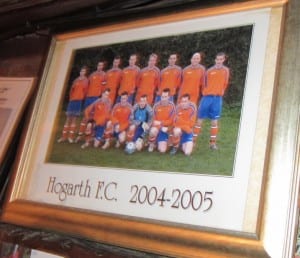Hogarthian Peregrinations
By Martine Rouleau, on 12 April 2013
Guest Blog Post by Bolognese, Aydon, Phelan, Cox & Bin
TRAVELS.2013.VOL.II
AN ACCOUNT
of what Seem’d most Remarkable in the Two Day Peregrination
of the Following Five Persons
Bolognese, Aydon, Phelan, Cox & Bin. Begun on Saturday February the 23rd. 2013 and Finish’d
On the 24th. Of the same Month
In 1732 Hogarth, Scott, Thornhill, Tothall and Forrest departed from the Bedford Arms inn in Covent Garden and began a five day tour around the North of Kent. Their expedition was documented in a manuscript now residing in the British Museum. They recorded the details of their trip, as well as the accounts, and also included ten illustrations to accompany the text. The manuscript was printed by Richard Livesay in 1782 while he was a lodger at the home of Hogarth’s widow. One of these printed versions resides in the UCL Art Museum and it was this item that we chose to research for our Collections Curatorship course.
We had decided from the outset that if we chose this collection of prints to research, we would attempt to recreate the trip originally undertaken just over 280 years ago. We were eager to see how the peregrination could be replicated with another group of five friends. We spoke about creating our own accounts page and seeing how much it would cost to undertake the tour today. It was discussed whether it was possible to go by boat, but as we are all students and this proved costly, we chose to hire a car. We “set sail” so to speak on Saturday 23rd February 2013 after concluding that it would be possible to visit the major sites of interest mentioned in the text over a two day period. Four of us were able to take part on Day 1 and three on Day 2.
Hoo
The original party had some adventures in Hoo Churchyard. Apart from reading epitaphs, Hogarth relieved himself on a grave rail much to the horror of Tothall who “administered penance to the offending parts” with some nettles. To satisfy his companion, Hogarth finished his business on the Church door instead.

Isle of Grain
We finished up Day 1 of our peregrination at the aptly named “Hogarth Inn” on the Isle of Grain. This was the last point the original group visited on the northern side of the Thames before getting a boat to Sheerness. The local football team, Hogarth F.C., had just won a match 4-0 and the pub was crowded.
A local man asked us where we were from and why we were visiting. We explained about the 1732 Peregrination and he already knew all about it. He said that he was born in Stoke in 1953. This was the year of the Queen’s coronation, and every child born that year was given a gift of the history of the town of their birth. He knew about the trip because in his booklet it stated that Hogarth had stayed in the stables in Stoke while passing through. Having researched since, it seems that the Queen did give a book to schoolchildren in each county that detailed historical events and Royal connections to that county in the year of her coronation.

As a final stop, we had an early dinner at the Crown in Rochester, located just opposite the site of the original Crown Inn where, in 1732, the group had indulged on soles and flounders with crab sauce, stuffed and roasted calf’s heart, fried liver, roast mutton and peas and beer – though the only part of this feast we were able to replicate was the drink. At about 8 o’clock we arrived back in London, in the same good humour we left it to set out on this very pleasant expedition. Over the course of the trip there had been no singing contests with local seamen, no cow dung fights, no punitive whipping with nettles and no treacherous journey by boat. The look of this part of Kent had also changed much in the over 280 years which had elapsed since the original peregrination. The oil refineries that dot the industrial coastline of the Isle of Sheppey were hardly the bucolic paradise that touched the pre-Romantic sensitivities of Hogarth and company. Other parts, though, seemed frozen in time: the cold Parish Church in Minster, the Norman castle in Rochester, the shore by Upnor castle, the semi-deserted High Street in Queenborough. In essence, our trip had much the same flavour as it did for our more famous predecessors: a welcome break from busy London life for five people of around the same age, enjoying each other’s company in a beautiful, friendly part of England that attracts less tourism than it probably deserves.
I think I cannot better conclude than with taking notice that not one of the company was unemployed; for Mr Aydon made the map, Ms Bin the drawings, Ms Cox was our treasurer, which (though a place of the greatest trust) she faithfully discharged, and the foregoing Memoir was a work of
J. PHELAN
M. BOLOGNESE
The veracity of this account is attested by us,
J. AYDON
V. BIN
C. COX
 Close
Close



